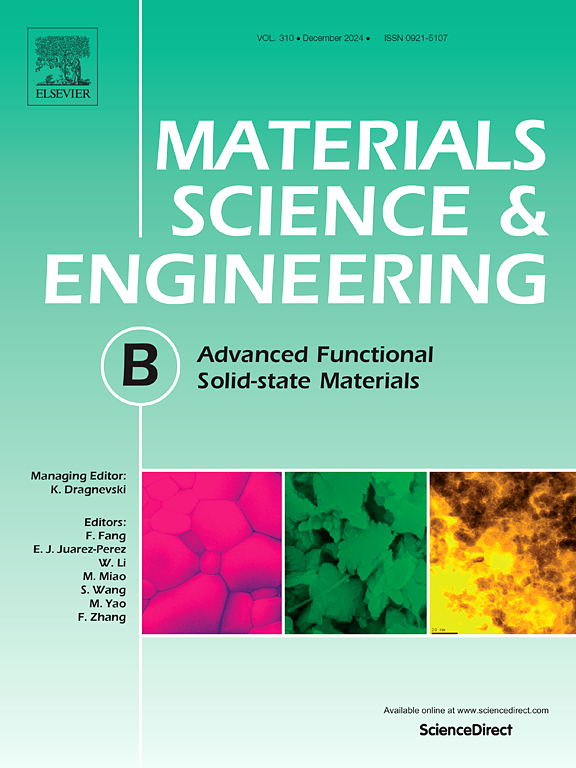氧化聚乙烯醇纳米复合材料中ZnO纳米粒子的原位合成及其可调光电和质子导电性能
IF 4.6
3区 材料科学
Q2 MATERIALS SCIENCE, MULTIDISCIPLINARY
引用次数: 0
摘要
本文介绍了在氧化聚乙烯醇(OPVA)基体上原位合成氧化锌(ZnO)纳米粒子,大大提高了最终纳米复合材料的光学、机械和质子导电性能。以乙酸锌为前驱体,在OPVA基质中合成了不同浓度(1 wt%、5 wt%和10 wt%)的ZnO纳米颗粒。由于这种原位方法,ZnO纳米颗粒可以均匀分散并与OPVA具有强的界面相互作用,这是传统的非原位技术难以实现的。纳米复合材料增强了光学特性,包括可调带隙从2.64 eV(纯OPVA)上升到3.27 eV (1% ZnO),使其适合用于紫外线阻挡膜和透明薄膜晶体管(TFTs)。此外,在90°C下,1 wt% ZnO复合材料的质子电导率为55 mS/cm,这表明它可能用于能量系统的质子交换膜。力学表征表明,当ZnO含量为5 wt%时,拉伸强度提高了45%,但当ZnO含量较高时,纳米颗粒发生聚集,柔韧性略有降低。这些结果突出了ZnO/OPVA纳米复合材料在光电应用和其他尖端技术方面的潜力,特别是在提高导电性,机械强度和光学透明度至关重要的情况下。本文章由计算机程序翻译,如有差异,请以英文原文为准。
In-situ synthesis of ZnO nanoparticles in oxidized polyvinyl alcohol nanocomposites for tunable optoelectronic and proton conductive performance
This work presents the in-situ synthesis of zinc oxide (ZnO) nanoparticles in an oxidized polyvinyl alcohol (OPVA) matrix, which greatly enhances the final nanocomposites optical, mechanical, and proton conductive properties. Zinc acetate was used as a precursor to synthesis ZnO nanoparticles at different concentrations (1 wt%, 5 wt%, and 10 wt%) within the OPVA matrix. ZnO nanoparticles can be uniformly dispersed and have strong interfacial interactions with the OPVA thanks to this in-situ method, which is difficult to accomplish with conventional ex-situ techniques. The nanocomposites enhanced optical characteristics, which included a tunable bandgap that rose from 2.64 eV (pure OPVA) to 3.27 eV (1 % ZnO), made them appropriate for use in UV-blocking films and transparent thin-film transistors (TFTs). Furthermore, the proton conductivity of 1 wt% ZnO composite was 55 mS/cm at 90 °C, suggesting possible uses in proton exchange membranes for energy systems. Mechanical characterization showed that at 5 wt% ZnO, tensile strength increased by 45 %, but at higher ZnO loadings, nanoparticle aggregation occurred, slightly reducing flexibility. These results highlight ZnO/OPVA nanocomposites potential for optoelectronic applications and other cutting-edge technologies, especially in situations where improved conductivity, mechanical strength, and optical transparency are essential.
求助全文
通过发布文献求助,成功后即可免费获取论文全文。
去求助
来源期刊

Materials Science and Engineering: B
工程技术-材料科学:综合
CiteScore
5.60
自引率
2.80%
发文量
481
审稿时长
3.5 months
期刊介绍:
The journal provides an international medium for the publication of theoretical and experimental studies and reviews related to the electronic, electrochemical, ionic, magnetic, optical, and biosensing properties of solid state materials in bulk, thin film and particulate forms. Papers dealing with synthesis, processing, characterization, structure, physical properties and computational aspects of nano-crystalline, crystalline, amorphous and glassy forms of ceramics, semiconductors, layered insertion compounds, low-dimensional compounds and systems, fast-ion conductors, polymers and dielectrics are viewed as suitable for publication. Articles focused on nano-structured aspects of these advanced solid-state materials will also be considered suitable.
 求助内容:
求助内容: 应助结果提醒方式:
应助结果提醒方式:


